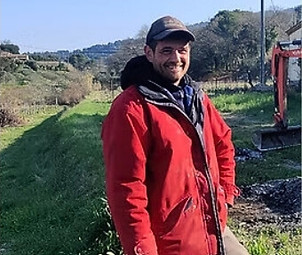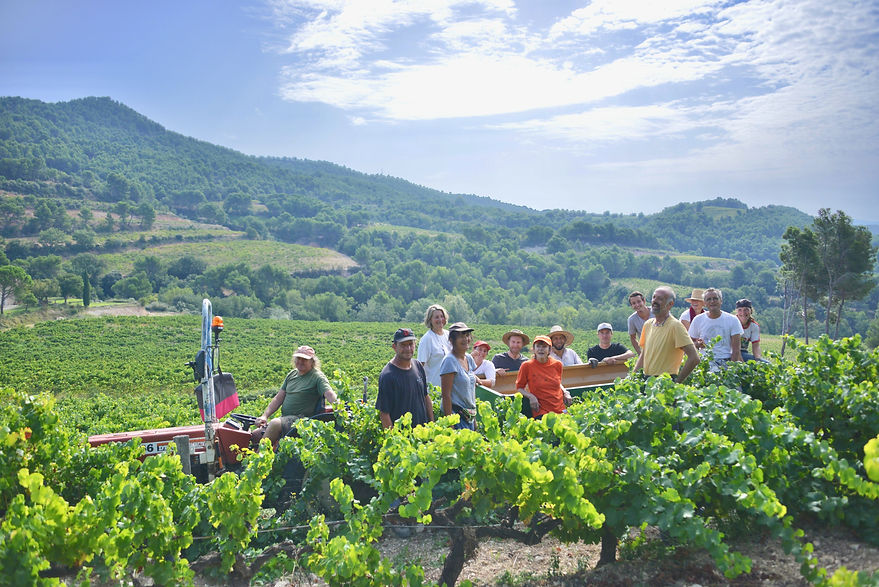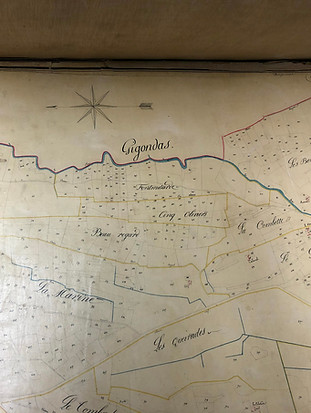
The History
Our Story
1976
Beyond exceptional terroirs, what makes the cuvées of the Clos de Caveau unique is their history. The fruit of many years of reflection, research and experimentation, each cuvée reveals the imprint of a family, a terroir, a community.
Gérard and Nicole Bungener purchase the estate from Stephen Spurrier; their children Patricia, Alec, and Henri join the family adventure.

Patricia Bungener and her daughter Julie, October 1976

Alec and Jim Bungener, 1977 — The first harvests were stored in wooden crates.

1980
Transition to chemical-free viticulture.
1989
Official organic certification.
1994
Henri Bungener becomes the estate’s winemaker.

Henri Bungener, 1979: "Quite quickly, we moved from wooden harvest crates to plastic ones."
2007
Birth of the signature cuvées: Fruit Sauvage, Carmin Brillant, and Lao Muse.
2012
Creation of the wine tourism circuit.
2017
Purchase of 0.5 hectares in Gigondas 200 meters from the farmhouse : the Champvermeil cuvée is created.

A place, a family, a community
Today

Henri Bungener / Owner & Winemaker
After a career as a psychoanalyst in London, Henri Bungener moved to Vacqueyras with his family in 2005 to take over the management of the family estate. A new kind of patient awaited him: the vineyard of Clos de Caveau, purchased by his father in 1976 and cultivated without pesticides or chemical products since 1980. To craft terroir-driven wines that truly reflect this unique place, he spent the following decades studying and closely observing the remarkable soils of Clos de Caveau.
Email : h@closdecaveau.com
Favorite grape variety: Grenache, for its ability to express the terroir.

Jean-Sébastien Sastre
/ Vineyard Manager
Favorite grape variety: Mourvèdre, for its roundness and deep color.

Damien Rigaud
/ Cellar Master
Favorite grape variety: Syrah, for its silky texture and spicy notes.

Hélène Roux / Accountant
Can’t live without: Moments of rejuvenation in the surrounding nature.

Perrine
/ Gîtes Manager

The team that nurtures the land
Local History
Winemaking in Provence
As early as the 1st century BC, the Romans introduced vines to the Rhône Valley. The remains of a Roman villa have been discovered in Vacqueyras - from the Latin Valléa Quadreria, ‘the valley of stones’.
On the Carmin Brillant terraces, we found traces of Roman activity: the remains of a lime kiln. These were used to heat limestone in order to produce lime, a building material used by the Romans.
The first written evidence of winegrowing dates back to the Middle Ages: in 1414, maps mention the presence of vines in the village, and in 1448, taxes were levied on grapes and wine. In 1791, after 500 years of papal ownership, the vines of the Comtat Venaissin, including those in Vacqueyras, were ceded to France following the French revolution.



Creation of the Vacqueyras AOC
The Vacqueyras terroir is a defined geographical area, which is protected by the Dentelles de Montmirail and benefits from a great diversity of soil types : pebbles, fine sands, clay, marl, safre, sandstone, gravel, and fragments of white limestone. The appellation comes with strict rules about wine growing and winemaking to ensure high quality and a coherent identity, including low yields (36 hectolitres per hectare), minimum age of vines, selective hand-harvesting and grape varietals.
-
1937 : Integration into AOC Côtes du Rhône
-
1955 : Recognised as Côtes du Rhône Villages
-
1990 : Vacqueyras is elevated to Cru des Côtes du Rhône and the AOC is officially formed for reds, whites and rosés.
Creation of the Gigondas AOC
Gigondas, whose name comes from the Latin jucunditas (‘pleasure’), has a wine-growing tradition that also dates back to the Roman era. Situated in altitude at the foot of the Dentelles de Montmirail, the limestone terroir and Mediterranean climate produce deep, structured and complex wines with impressive aging potential.
-
1937 : Becomes part of the Côtes du Rhône AOC
-
1971 : First village to become a Cru (reds & rosés)
-
2023 : Official recognition of white wines in the AOC






